Cracking Capuchins
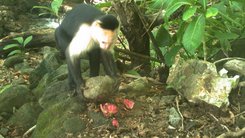
White-faced capuchin monkeys (Cebus capucinus imitator) living on the islands of Coiba and Jicarón in Coiba National Park, Panama, present scientists with an intriguing mystery. For at least a decade, several groups of capuchins on these islands have been using stone tools to crack open fruits, nuts, and invertebrates, a behavior never before observed in any other Cebus group around the world (described here and here). Why is this likely useful behavior limited to only some groups on the islands and absent from all groups on the mainland? My PhD research aims to tackle this big why question (more details on the overarching ISLaS page) by using non-invasive methods to learn more about the who, when, where, and how of stone tool use by Coiban capuchins.
Tool Use: from Termite Fishing to Toothbrushes
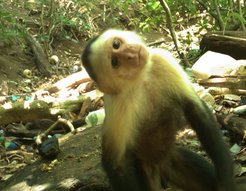
Credit: Odd Jacobson
Tool use plays a central part in everyday human lives across the globe: from spears to can openers and toothbrushes, we employ a myriad of tools to accomplish a variety of tasks and solve a multitude of problems. We consider ourselves the most proficient tool users in the animal kingdom and, as such, much research is dedicated to elucidating evolutionary drivers of human tool use. However, tool use is widespread in the animal kingdom; for example chimpanzees use sticks for termite fishing, and bees use animal feces as deterrents to defend their colonies. Tool use represents an innovative method for solving problems or improving the efficiency of tasks. Once it arises in one individual, it can spread to other individuals via social learning. The tool-using white-faced capuchins living on the islands of Coiba and Jicarón are unique for several reasons. Not only are they the first known example in the entire genus of gracile (Cebus) capuchins using tools, but the tool use that they show is percussive stone technology. Habitual stone tool use, which aside from in humans is only observed in chimpanzees, long-tailed macaques, and tufted capuchins (Sapajus spp.), is thought to have played an important role in human evolution.
As part of the ISLaS team led by Dr. Brendan Barrett, my PhD research focuses on the tool-using behavior of white-faced capuchins living on Coiba and Jicarón (henceforth the Coiban capuchins). I aim to study who is using tools, when and where tools are used, and how flexible the tool use behavior is. Establishing this information will help us understand why tool use arose in these groups of capuchins when it did not in others, and, more broadly, what social and ecological factors drive tool use to arise and be maintained in both human and non-human animals.
Conducting non-invasive research
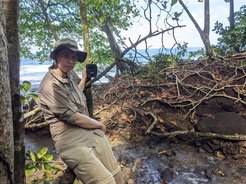
My project poses unique methodological challenges because Jicarón is a particularly remote, uninhabited island, and the capuchins here are not used to the presence of humans. Additionally, I believe that animal welfare is central to any study of animal behavior: science should not only increase our understanding of the world around us, but also positively impact the involved animals (human and non-human alike). As such, one aim of my PhD research is to demonstrate that rare behaviors like tool use and social learning processes can be studied effectively using minimally invasive methods.
Camera traps play a central role in my project as they allow us to remotely record the capuchins’ behavior. While camera traps are not as invasive as being followed by observers or fitted with a GPS collar, the capuchins definitely still take note of them and take their time to inspect (and try to destroy) them. Thus, camera traps are mounted to trees in indestructible cases that even the most curious capuchin cannot pry open. As the cameras also pick up animals that are not capuchins, they have the additional benefit of allowing us to catalogue the diversity of animals living in Coiba National Park.
Who Uses Tools: Sex Bias or Sampling Bias?
Understanding differences in the tendency to use tools between age and sex classes is crucial to understanding why tool use may differ between groups. This is because a tool-using behavior can only spread to other groups if the individuals that use tools disperse to other groups and subsequently expose individuals in these groups to the behavior. In white-faced capuchins, males are typically the dispersing sex, but we need to confirm whether this is true for the Coiban capuchins. Current knowledge suggests that the male capuchins are using stone tools more frequently than females, especially on the island of Jicarón. A range of explanations could account for this observation: for instance, the stone tools could be too heavy for females to use properly, or females may be out-competed at anvil sites by more dominant males. However, several females on Coiba have been observed using stone tools successfully, which shows that at least female capuchins are physically capable of using tools.
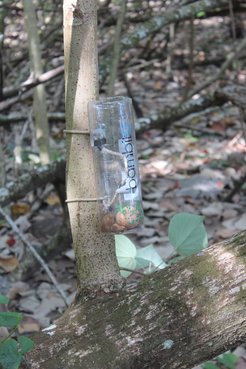
However, while a true sex bias might be present, the observed sex difference could also be due to a sampling bias. Our camera traps are not placed at random locations, but mostly aimed at anvils close to sea almond trees, a food frequently consumed using tools. Most of the female tool-users on Coiba, where female tool use appears to be more common, use tools to eat snails and crabs, not sea almonds. So perhaps by placing our cameras largely at sea almond anvils, we are missing many instances of female tool use. We examine this and further hypotheses in our article on the male-biased tool use on Jicarón, which you can read here. In addition to investigating a potential sex difference in who uses tools, I will also explore age differences in tool use frequency and technique.
To answer questions about who uses tools, I need to be able to distinguish individual capuchins from one another in the camera trap footage. To do this, I will benefit from a collaboration between the ISLaS project and Prof. Chuck Stewart’s group at RPI, which is working to develop neural networks that can recognize individual capuchins from camera trap images. We will also use DNA samples obtained via feces samples and hair traps to obtain information about group composition and dispersal tendencies, which is crucial to understanding the potential sex-bias in tool use. By placing a desirable food item (e.g., an egg) in a tube lined with adhesive tape on the inside, hair can be pulled from capuchins reaching for the food with minimal disturbance to them and without needing to sedate animals.
Where and When: Location and Timing of Tool Use
A possible explanation for why habitual (stone) tool use never arose in long-term Cebus study sites, but did on Coiba and Jicarón, may be that Coiba and Jicarón are islands. Habitual tool-use is observed in many endemic island-living species (e.g., New-Caledonian crows), or restricted to populations that live on islands (i.e., Burmese long-tailed macaques). Due to their size and isolation from the mainland, islands present a unique set of environmental conditions, which reduces species richness and the variety of food available. However, in the case of the Coiban capuchins, it presents a benefit as well: there are no large terrestrial predators on either of the islands. Likely as a result, Coiban capuchins are much more terrestrial than their mainland counterparts, and spend extended periods of time foraging, traveling, and even sleeping, on the forest floor.
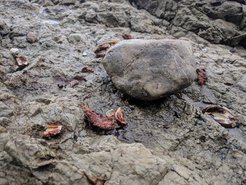
I want to explore other ways in which living on islands and using tools have altered the daily activity pattern and habitat use of the Coiban capuchins. Both tool-using and non-tool-using Coiban capuchins exploit tidal resources like crabs (see figure on the right) and snails, that are only available at low tide. How do these dynamic, high quality resources with fluctuating availability affect daily activity patterns and space use? This may also differ between tool-using and non-tool-using groups, as the tool users can access a wider range of intertidal resources. Our article on the link between tool use and tidal cycles is available here.
The camera traps play a crucial role in answering these (and more) questions. Camera traps can be placed either at targeted locations that are likely to be visited by the animals of interest (e.g., at a tool-use site as mentioned previously), or in a systematic grid/at random locations relative to movement of the animals. I plan to use both approaches to collect data on the Coiban capuchins, in order to obtain detailed information on the tool-using behavior itself as well as more general information about daily activity, group composition, and movement.
How Tool Use Affects Flexibility: When Your Tools Don’t Work Like They Used to Before
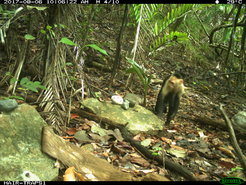
Not all groups of Coiban capuchins seem to use tools: at least one group on each island has been observed using tools, but current evidence suggests tool use is absent in other groups on the islands. This provides the unique opportunity to conduct non-invasive experiments with both a comparison between the tool-users on the two different islands, and a natural control group of non-tool-users within each island. We plan to leverage this situation to apply the same experimental set-up to at least four groups: one group of tool-users and one group of non-tool-users on both Jicarón and Coiba.
In the experiment, we will explore how tool-users respond to changes in resource properties that reduce the efficiency of tool use. In this situation, tool-using capuchins will have to flexibly adapt their behavior to this novel situation by either inhibiting the use of tools in favor of alternative strategies – which in the past never yielded the highest pay-off – or by inventing novel techniques. Does memory and their long reliance on tool use constrain their ability to learn and flexibly adapt their behavior? If this challenge is overcome, how does the knowledge of this solution spread throughout the group?
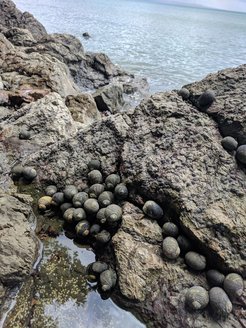
We plan to place two experimental anvils (see picture above) in locations within each group’s frequently visited range , with cameras placed around it to film capuchins around and on the anvils from several angles. Our proposed experiment will consist of two phases: a baseline and an experimental phase. During the baseline, each anvil will be baited with a bucket of snails that occur on the coast of the islands (see picture on the right) and are often consumed by both tool-users and non-tool-users. By recording in detail how the capuchins consume these snails, we can obtain information about the differences in tool-using technique between the two islands, and how efficient tool-using is compared to not using tools. In the experimental phase, the familiar snails will be replaced with another species that lives deeper in the intertidal zone at the islands: the capuchins likely have not encountered it before, but it is a naturally occurring species in their habitat. The ‘catch’ with these snails is their tougher shell, and they cannot be opened using tools. The non-tool-users can likely continue to use their technique of pounding the snail until it falls out of its shell, but tool users will now be forced to either adopt this behavior or innovate a novel solution.
The data we obtain from this experiment will be analyzed using EWA models to see if and how new innovations spread, and to estimate individual differences in switching behavior and exploration of different techniques. Before going to the field, I will simulate data based on my experimental design to make sure my proposed methods can address the hypothesized learning strategies, and to guarantee we conduct the experiment as efficiently as possible. While we wish to study the flexibility of the tool use behavior of these capuchins, we do not want to cause lasting changes to their natural behavior (e.g., causing the extinction of the tool use tradition). Therefore, we have designed the task to be as close to natural circumstances as possible, not using novel stimuli but rather adapting food resources already in their diet.
Want to learn more about …
The Coiban capuchins or the islands of Coiba and Jicáron? Take a look at the ISLaS page describing the overarching project with the Coiban capuchins.
The behavior of capuchins in mainland populations? You can explore the daily life of a capuchin here on how to be a monkey
Animals using tools? Check out this minireview on tool use in the animal kingdom: Animal Tool-Use (2010) or this interactive catalogue of animals using tools by National Geographic
Further reading on non-invasive research and ethics
The welfare and ethics of research involving wild animals: A primer (2020)
Credits for all photos are to Brendan J. Barrett & the MPI of Animal Behavior (for those from camera traps)
Written by Zoë Goldsborough, Department for the Ecology of Animal Societies






